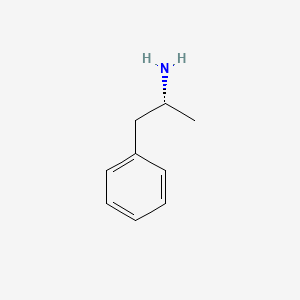

1. Amfetamine
2. Amphetamine
3. Amphetamine Sulfate
4. Amphetamine Sulfate (2:1)
5. Centramina
6. Desoxynorephedrin
7. Fenamine
8. L Amphetamine
9. L-amphetamine
10. Levo Amphetamine
11. Levo-amphetamine
12. Levoamphetamine
13. Mydrial
14. Phenamine
15. Phenopromin
16. Sulfate, Amphetamine
17. Thyramine
1. L-amphetamine
2. Levamphetamine
3. (r)-amphetamine
4. 156-34-3
5. (2r)-1-phenylpropan-2-amine
6. (-)-amphetamine
7. (r)-1-phenylpropan-2-amine
8. L-(r)-amphetamine
9. (r)-alpha-methylbenzeneethanamine
10. (r)-alpha-methylphenethylamine
11. (-)-phenylisopropylamine
12. L-alpha-methylphenethylamine
13. Amphetamine L-form
14. Amfetamine, (r)-
15. Levamfetamine (in Methanol)
16. Chembl19393
17. Chebi:42724
18. R87us8p740
19. Levamphetaminum
20. Levamfetamina [dcit]
21. Levamfetamina
22. Levamfetaminum
23. Levanfetamina
24. R-amphetamine
25. Levamfetamine [inn:ban]
26. R(-)amphetamine
27. Levamfetaminum [inn-latin]
28. Levanfetamina [inn-spanish]
29. (-)-alpha-methylphenethylamine
30. Einecs 205-850-8
31. L-amphetamine Hydrochloride
32. Unii-r87us8p740
33. (r)-phenaminum
34. Phenethylamine, Alpha-methyl-, (-)-
35. Benzeneethanamine, Alpha-methyl-, (r)-
36. L-a-methylphenethylamine
37. (r)-phenylisopropylamine
38. (r)-a-methylphenethylamine
39. Levamfetamine [inn]
40. Schembl2636
41. (r)-a-methylbenzeneethanamine
42. (r)-a-methyl-benzeneethanamine
43. Gtpl2146
44. (r)-amphetamine; Levamphetamine
45. Amphetamine L-form [mi]
46. Dtxsid20166016
47. (r)-alpha-methyl-benzeneethanamine
48. Act09042
49. Zinc6036847
50. Bdbm50022721
51. Pdsp1_001510
52. Pdsp2_001494
53. Akos022172419
54. C105
55. (r)-1-methyl-2-phenyl-ethylamine
56. (-)-(r)-.alpha.-methylphenethylamine
57. (-)-(r)-.alpha.-methylbenzeneethanamine
58. Q2506823
59. R(-)-amphetamine (levo-amphetamine), 1.0 Mg/ml In Methanol, Ampule Of 1 Ml, Certified Reference Material
| Molecular Weight | 135.21 g/mol |
|---|---|
| Molecular Formula | C9H13N |
| XLogP3 | 1.8 |
| Hydrogen Bond Donor Count | 1 |
| Hydrogen Bond Acceptor Count | 1 |
| Rotatable Bond Count | 2 |
| Exact Mass | 135.104799419 g/mol |
| Monoisotopic Mass | 135.104799419 g/mol |
| Topological Polar Surface Area | 26 Ų |
| Heavy Atom Count | 10 |
| Formal Charge | 0 |
| Complexity | 84.7 |
| Isotope Atom Count | 0 |
| Defined Atom Stereocenter Count | 1 |
| Undefined Atom Stereocenter Count | 0 |
| Defined Bond Stereocenter Count | 0 |
| Undefined Bond Stereocenter Count | 0 |
| Covalently Bonded Unit Count | 1 |
Central Nervous System Stimulants
A loosely defined group of drugs that tend to increase behavioral alertness, agitation, or excitation. They work by a variety of mechanisms, but usually not by direct excitation of neurons. The many drugs that have such actions as side effects to their main therapeutic use are not included here. (See all compounds classified as Central Nervous System Stimulants.)
Adrenergic Agents
Drugs that act on adrenergic receptors or affect the life cycle of adrenergic transmitters. Included here are adrenergic agonists and antagonists and agents that affect the synthesis, storage, uptake, metabolism, or release of adrenergic transmitters. (See all compounds classified as Adrenergic Agents.)
Adrenergic Uptake Inhibitors
Drugs that block the transport of adrenergic transmitters into axon terminals or into storage vesicles within terminals. The tricyclic antidepressants (ANTIDEPRESSIVE AGENTS, TRICYCLIC) and amphetamines are among the therapeutically important drugs that may act via inhibition of adrenergic transport. Many of these drugs also block transport of serotonin. (See all compounds classified as Adrenergic Uptake Inhibitors.)
Dopamine Agents
Any drugs that are used for their effects on dopamine receptors, on the life cycle of dopamine, or on the survival of dopaminergic neurons. (See all compounds classified as Dopamine Agents.)
Dopamine Uptake Inhibitors
Drugs that block the transport of DOPAMINE into axon terminals or into storage vesicles within terminals. Most of the ADRENERGIC UPTAKE INHIBITORS also inhibit dopamine uptake. (See all compounds classified as Dopamine Uptake Inhibitors.)
Sympathomimetics
Drugs that mimic the effects of stimulating postganglionic adrenergic sympathetic nerves. Included here are drugs that directly stimulate adrenergic receptors and drugs that act indirectly by provoking the release of adrenergic transmitters. (See all compounds classified as Sympathomimetics.)
Amphetamine has known human metabolites that include 4-Hydroxyamphetamine.
S73 | METXBIODB | Metabolite Reaction Database from BioTransformer | DOI:10.5281/zenodo.4056560
MARKET PLACE


